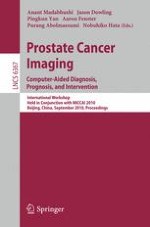2010 | OriginalPaper | Buchkapitel
High-Throughput Prostate Cancer Gland Detection, Segmentation, and Classification from Digitized Needle Core Biopsies
verfasst von : Jun Xu, Rachel Sparks, Andrew Janowczyk, John E. Tomaszewski, Michael D. Feldman, Anant Madabhushi
Erschienen in: Prostate Cancer Imaging. Computer-Aided Diagnosis, Prognosis, and Intervention
Verlag: Springer Berlin Heidelberg
Aktivieren Sie unsere intelligente Suche, um passende Fachinhalte oder Patente zu finden.
Wählen Sie Textabschnitte aus um mit Künstlicher Intelligenz passenden Patente zu finden. powered by
Markieren Sie Textabschnitte, um KI-gestützt weitere passende Inhalte zu finden. powered by
We present a high-throughput computer-aided system for the segmentation and classification of glands in high resolution digitized images of needle core biopsy samples of the prostate. It will allow for rapid and accurate identification of suspicious regions on these samples. The system includes the following three modules: 1) a hierarchical frequency weighted mean shift normalized cut (HNCut) for initial detection of glands; 2) a geodesic active contour (GAC) model for gland segmentation; and 3) a diffeomorphic based similarity (DBS) feature extraction for classification of glands as benign or cancerous. HNCut is a minimally supervised color based detection scheme that combines the frequency weighted mean shift and normalized cuts algorithms to detect the lumen region of candidate glands. A GAC model, initialized using the results of HNCut, uses a color gradient based edge detection function for accurate gland segmentation. Lastly, DBS features are a set of morphometric features derived from the nonlinear dimensionality reduction of a dissimilarity metric between shape models. The system integrates these modules to enable the rapid detection, segmentation, and classification of glands on prostate biopsy images. Across 23 H & E stained prostate studies of whole-slides, 105 regions of interests (ROIs) were selected for the evaluation of segmentation and classification. The segmentation results were evaluated on 10 ROIs and compared to manual segmentation in terms of mean distance (2.6 ±0.2 pixels), overlap (62±0.07%), sensitivity (85±0.01%), specificity (94±0.003%) and positive predictive value (68±0.08%). Over 105 ROIs, the classification accuracy for glands automatically segmented was (82.5 ±9.10%) while the accuracy for glands manually segmented was (82.89 ±3.97%); no statistically significant differences were identified between the classification results.
